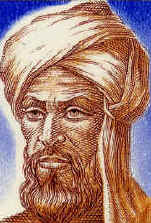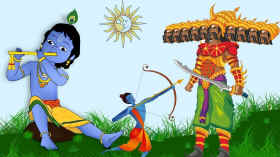

D Vautier
11/2022
Our Number system, the Hindu-Arabic
is based on a unique
method of counting developed in India around 300 BCE. Most of the world today
uses this system to do almost every kind of counting and
all higher
mathematics. Actually it's built into our blood ever since we
started counting with wooden blocks as little children. We learned our
times tables, addition and subtraction, long division.
 But for most of
western history, the civilized world used
the Roman Numeral counting system, which remained in use in western
civilization for well over 1500 years from early Rome until about the
end of the middle ages. There were of course many other counting
systems throughout the world but the Roman counting system kept the western world
operating because it worked pretty well and it was very easy to
understand. I call it the bag system because it counted smaller
and larger groups of bags. One bag was I, five bags was V, ten
bags were X, and so on. It was a very practical way to count bags.
But for most of
western history, the civilized world used
the Roman Numeral counting system, which remained in use in western
civilization for well over 1500 years from early Rome until about the
end of the middle ages. There were of course many other counting
systems throughout the world but the Roman counting system kept the western world
operating because it worked pretty well and it was very easy to
understand. I call it the bag system because it counted smaller
and larger groups of bags. One bag was I, five bags was V, ten
bags were X, and so on. It was a very practical way to count bags.
On the other hand the early Hindu mathematicians devised a much better way of counting, calculating, and manipulating numbers. It was based on a decimal system and had 9 distinct figures representing the continuous values 1 through 9. It could assign each number a value based on powers of ten depending on a set of suffixes, e.g. sata for hundred, dasan for tens and the units column was unnamed. So ď2 sata, 4 dasan, 5Ē was 245, and ď3 sata, 5Ē was 305. The system worked well especially for larger numbers and was adopted by the Arabs who carried on a very active trade with India and the middle east. The Arabs didnít like the shape of the goofy Hindu symbols used because they were so squiggly and confusing so the Arabs substituted their own shapes to form number values that looked a lot clearer and also very close to what we use today. That was the extent of Arab involvement in the Hindu number system.
 Then a brilliant Indian
scientist from Kusumapura, Patna, India appeared on the scene. His
name was Aryabhata (a-ra-BA-ta) (476-550 CE). He invented the zero
which didnít really mean zero at all. It instead was simply a place holder to show
an empty value (sunya) for a given column. This eliminated the
column suffixes so instead of having to
write ď3 sata, 5Ē, you just needed to write 305. This was a really
cool
improvement.
Then a brilliant Indian
scientist from Kusumapura, Patna, India appeared on the scene. His
name was Aryabhata (a-ra-BA-ta) (476-550 CE). He invented the zero
which didnít really mean zero at all. It instead was simply a place holder to show
an empty value (sunya) for a given column. This eliminated the
column suffixes so instead of having to
write ď3 sata, 5Ē, you just needed to write 305. This was a really
cool
improvement.
 Some years later, actually a lot
of years later like 300 years, an absolute genius came along,
Al-Khwarizmi (al-qua-RIS-mi), (780-850 CE), from Persia, who not
only invented algebra, but wrote a number of books about all sorts of
other things like exponentials, squares and square roots. Algebra and
algorithm are words derived from his name.
Some years later, actually a lot
of years later like 300 years, an absolute genius came along,
Al-Khwarizmi (al-qua-RIS-mi), (780-850 CE), from Persia, who not
only invented algebra, but wrote a number of books about all sorts of
other things like exponentials, squares and square roots. Algebra and
algorithm are words derived from his name.
All this great scientific activity was going on while Europe was in the depth of the dark ages. However some of Al-Khwarizmiís (al-qua-RIS-miís) books were later translated into Latin, mainly his Algoritmi de Numero Indorum but it did not appear in Europe until around 1000 AD. I donít think Europe was even ready for it then. The guy who first translated the Algoritmi was said to be a Spanish Scientist who was sort of able to understand this first book about algebra, but his translation may have been poorly done. So it probably was not until the 1300's that his Algoritmi was properly translated.
The Catholic Church at that time controlled learning, reading, writing and most of the little scientific activity that actually went on. In fact, the monks were usually the only ones who could read or write. There were also bookkeepers who could keep track of inventory and various goods and deal with business matters. Also innkeepers, shepherds, farmers all had to rely on the rudimentary Roman system but their activities were restricted mostly to just counting, adding and subtracting which was easy to do with Roman Numerals* and required no special education or schooling.
Itís really not fair to say that the Church was opposed to new ideas (the Galileo thing) and moreover, the introduction of the Hindu system was enthusiastically supported by Gerbert of Aurillac, who later became pope Silvester II (999-1006 CE). But the west was not ready for higher mathematics. There was no glairing need for it. Astronomy was still in the hands of God. After all, angels moved all the stars. Stronger angels moved the sun and moon so that was fine.
 So began the digital wars
sort of, between the Roman Numeral system and Hindu-Arabic Numeral system which
lasted until 1500 when printing came along.
So began the digital wars
sort of, between the Roman Numeral system and Hindu-Arabic Numeral system which
lasted until 1500 when printing came along.
When the 1100s started, Iím not sure there was any outright debate between the clerks and monks who used Roman Numeral counting systems and those who preferred the Hindu-Arabic Numerals. But I did read articles exploring some hypothetical discussions. The reasons why the Hindu-Arabic system took 400 years to be accepted may be summarized here.
 Advantages of
The Roman system
Advantages of
The Roman systemAddition and subtraction was far easier to do using the Roman system*. Accountants, clerks, innkeepers, inventory managers, shepherds, stable keepers and farmers all found that the primary function of any counting system was addition and subtraction. Other higher functions were unnecessary. And it was easy to learn with Roman.
The Roman system was harder to cheat on since all characters were the same size and not at all interchangeable or similar. I V X M L C were distinct and could not be easily modified.
On the other hand this new-fangled Hindu system had characters that could be changed, e.g. 7 to 1, 6 and 9 to 0, 1 to 4.
With Hindu-Arabic Numerals it took a lot of schooling to teach the basic arithmetic involved in just simple addition and subtraction, let alone higher functions. What is all this borrowing and carrying stuff about?
Why have a number that represents nothing anyway?
Not very much higher mathematics had been developed or even needed. Angels did all that complicated stuff.
However the new numbering system had to come and started to get used by the scientific community (whatever it was at the time) but not by the bean counters and innkeepers. But the Hindu system had unbelievable advantages whereas the Roman system suffered in many areas, such as:
 Advantages of Hindu system
Advantages of Hindu systemLarge numbers are totally unworkable in Roman, e.g. 29436 is XXIXCDXXXVI. (thatís expressed in the subtractive form of Roman. The additive form is longer).
Roman has no fractions. However it's fair to say that decimal points were introduced only later by John Napier well after the Hindu system was established. Would it have worked in Roman? I don't think so.
No negative numbers.
No high math possible.
Very difficult multiplying and division in Roman. Try it.
No algebra or calculus possible.
It is a wonder that the Roman system lasted well over 16 centuries but you have to remember that Newton (1642-1726) and Leibnitz (1646-1716) did not come along for another century after the Hindu system was finally established so the ground was set for those guys to do all their wonderful work using this marvelous system.
I have no citations in
this essay. All information is in the public domain.
* When adding or
subtracting Roman you use only the additive notation (VIIII not
IX). After addition, simplify (V V = X, XXXXX=L, IIIII=V, etc).
When subtracting, you cancel similar values out.